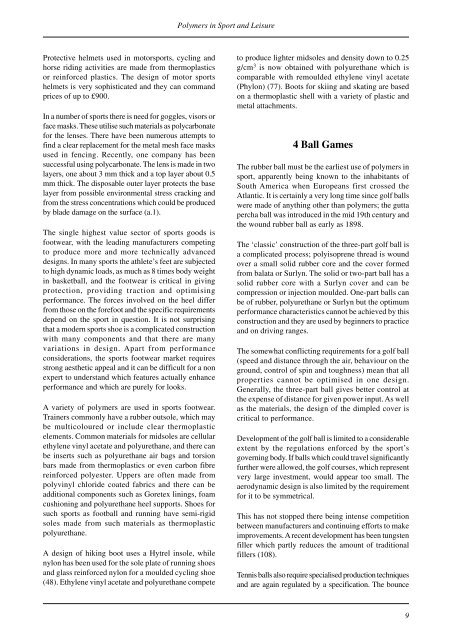Polymers in Sport and Leisure
Polymers in Sport and Leisure
Polymers in Sport and Leisure
Create successful ePaper yourself
Turn your PDF publications into a flip-book with our unique Google optimized e-Paper software.
<strong>Polymers</strong> <strong>in</strong> <strong>Sport</strong> <strong>and</strong> <strong>Leisure</strong><br />
Protective helmets used <strong>in</strong> motorsports, cycl<strong>in</strong>g <strong>and</strong><br />
horse rid<strong>in</strong>g activities are made from thermoplastics<br />
or re<strong>in</strong>forced plastics. The design of motor sports<br />
helmets is very sophisticated <strong>and</strong> they can comm<strong>and</strong><br />
prices of up to £900.<br />
In a number of sports there is need for goggles, visors or<br />
face masks. These utilise such materials as polycarbonate<br />
for the lenses. There have been numerous attempts to<br />
f<strong>in</strong>d a clear replacement for the metal mesh face masks<br />
used <strong>in</strong> fenc<strong>in</strong>g. Recently, one company has been<br />
successful us<strong>in</strong>g polycarbonate. The lens is made <strong>in</strong> two<br />
layers, one about 3 mm thick <strong>and</strong> a top layer about 0.5<br />
mm thick. The disposable outer layer protects the base<br />
layer from possible environmental stress crack<strong>in</strong>g <strong>and</strong><br />
from the stress concentrations which could be produced<br />
by blade damage on the surface (a.1).<br />
The s<strong>in</strong>gle highest value sector of sports goods is<br />
footwear, with the lead<strong>in</strong>g manufacturers compet<strong>in</strong>g<br />
to produce more <strong>and</strong> more technically advanced<br />
designs. In many sports the athlete’s feet are subjected<br />
to high dynamic loads, as much as 8 times body weight<br />
<strong>in</strong> basketball, <strong>and</strong> the footwear is critical <strong>in</strong> giv<strong>in</strong>g<br />
protection, provid<strong>in</strong>g traction <strong>and</strong> optimis<strong>in</strong>g<br />
performance. The forces <strong>in</strong>volved on the heel differ<br />
from those on the forefoot <strong>and</strong> the specific requirements<br />
depend on the sport <strong>in</strong> question. It is not surpris<strong>in</strong>g<br />
that a modern sports shoe is a complicated construction<br />
with many components <strong>and</strong> that there are many<br />
variations <strong>in</strong> design. Apart from performance<br />
considerations, the sports footwear market requires<br />
strong aesthetic appeal <strong>and</strong> it can be difficult for a non<br />
expert to underst<strong>and</strong> which features actually enhance<br />
performance <strong>and</strong> which are purely for looks.<br />
A variety of polymers are used <strong>in</strong> sports footwear.<br />
Tra<strong>in</strong>ers commonly have a rubber outsole, which may<br />
be multicoloured or <strong>in</strong>clude clear thermoplastic<br />
elements. Common materials for midsoles are cellular<br />
ethylene v<strong>in</strong>yl acetate <strong>and</strong> polyurethane, <strong>and</strong> there can<br />
be <strong>in</strong>serts such as polyurethane air bags <strong>and</strong> torsion<br />
bars made from thermoplastics or even carbon fibre<br />
re<strong>in</strong>forced polyester. Uppers are often made from<br />
polyv<strong>in</strong>yl chloride coated fabrics <strong>and</strong> there can be<br />
additional components such as Goretex l<strong>in</strong><strong>in</strong>gs, foam<br />
cushion<strong>in</strong>g <strong>and</strong> polyurethane heel supports. Shoes for<br />
such sports as football <strong>and</strong> runn<strong>in</strong>g have semi-rigid<br />
soles made from such materials as thermoplastic<br />
polyurethane.<br />
A design of hik<strong>in</strong>g boot uses a Hytrel <strong>in</strong>sole, while<br />
nylon has been used for the sole plate of runn<strong>in</strong>g shoes<br />
<strong>and</strong> glass re<strong>in</strong>forced nylon for a moulded cycl<strong>in</strong>g shoe<br />
(48). Ethylene v<strong>in</strong>yl acetate <strong>and</strong> polyurethane compete<br />
to produce lighter midsoles <strong>and</strong> density down to 0.25<br />
g/cm 3 is now obta<strong>in</strong>ed with polyurethane which is<br />
comparable with remoulded ethylene v<strong>in</strong>yl acetate<br />
(Phylon) (77). Boots for ski<strong>in</strong>g <strong>and</strong> skat<strong>in</strong>g are based<br />
on a thermoplastic shell with a variety of plastic <strong>and</strong><br />
metal attachments.<br />
4 Ball Games<br />
The rubber ball must be the earliest use of polymers <strong>in</strong><br />
sport, apparently be<strong>in</strong>g known to the <strong>in</strong>habitants of<br />
South America when Europeans first crossed the<br />
Atlantic. It is certa<strong>in</strong>ly a very long time s<strong>in</strong>ce golf balls<br />
were made of anyth<strong>in</strong>g other than polymers; the gutta<br />
percha ball was <strong>in</strong>troduced <strong>in</strong> the mid 19th century <strong>and</strong><br />
the wound rubber ball as early as 1898.<br />
The ‘classic’ construction of the three-part golf ball is<br />
a complicated process; polyisoprene thread is wound<br />
over a small solid rubber core <strong>and</strong> the cover formed<br />
from balata or Surlyn. The solid or two-part ball has a<br />
solid rubber core with a Surlyn cover <strong>and</strong> can be<br />
compression or <strong>in</strong>jection moulded. One-part balls can<br />
be of rubber, polyurethane or Surlyn but the optimum<br />
performance characteristics cannot be achieved by this<br />
construction <strong>and</strong> they are used by beg<strong>in</strong>ners to practice<br />
<strong>and</strong> on driv<strong>in</strong>g ranges.<br />
The somewhat conflict<strong>in</strong>g requirements for a golf ball<br />
(speed <strong>and</strong> distance through the air, behaviour on the<br />
ground, control of sp<strong>in</strong> <strong>and</strong> toughness) mean that all<br />
properties cannot be optimised <strong>in</strong> one design.<br />
Generally, the three-part ball gives better control at<br />
the expense of distance for given power <strong>in</strong>put. As well<br />
as the materials, the design of the dimpled cover is<br />
critical to performance.<br />
Development of the golf ball is limited to a considerable<br />
extent by the regulations enforced by the sport’s<br />
govern<strong>in</strong>g body. If balls which could travel significantly<br />
further were allowed, the golf courses, which represent<br />
very large <strong>in</strong>vestment, would appear too small. The<br />
aerodynamic design is also limited by the requirement<br />
for it to be symmetrical.<br />
This has not stopped there be<strong>in</strong>g <strong>in</strong>tense competition<br />
between manufacturers <strong>and</strong> cont<strong>in</strong>u<strong>in</strong>g efforts to make<br />
improvements. A recent development has been tungsten<br />
filler which partly reduces the amount of traditional<br />
fillers (108).<br />
Tennis balls also require specialised production techniques<br />
<strong>and</strong> are aga<strong>in</strong> regulated by a specification. The bounce<br />
9










